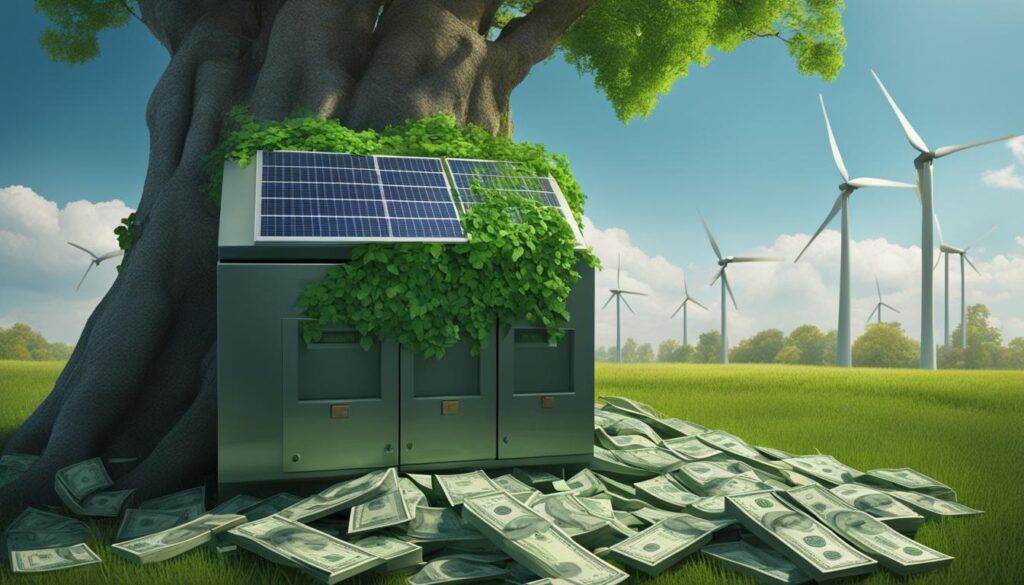As the world becomes more aware of the urgent need to address climate change, there is a growing demand for financial products that align with sustainability goals. Consumers are increasingly seeking out climate-conscious solutions, and financial institutions are rising to the challenge by offering a range of green and sustainable finance options.
These innovative financial products cater to individuals and businesses looking to make a positive impact on the environment while also achieving their financial goals. From green loans and mortgages to eco-friendly credit cards and investment funds, these offerings support renewable energy projects, energy efficiency initiatives, and other environmentally friendly ventures.
By embracing climate-smart financial products, individuals and businesses can actively contribute to reducing their carbon footprint and mitigating the effects of climate change. This not only benefits the planet but also presents opportunities for greener investments and sustainable economic growth.
Key Takeaways:
- Climate change financial products and green finance solutions are in high demand.
- Sustainable finance options cater to the growing climate-conscious consumer base.
- Green loans, mortgages, credit cards, and investment funds support renewable energy and eco-friendly initiatives.
- Green financial products help individuals and businesses reduce their carbon footprint.
- Eco-investment products offer opportunities for sustainable and responsible investing.
Understanding Green Investing and Sustainable Finance
Green investing and sustainable finance are key components in addressing climate change and promoting a more sustainable future. Green investing involves making financial investments in businesses or funds that prioritize reducing harmful pollutants and using resources more sustainably. This type of investment aims to create a positive environmental and social impact while still generating financial returns.
Renewable energy investments are a major focus of green investing. These investments support projects such as wind, solar, and hydropower that help reduce reliance on fossil fuels and decrease greenhouse gas emissions. Additionally, investments in green transportation, pollution controls, waste reduction, and sustainable agriculture further promote sustainability and environmental stewardship.
“Green investing allows individuals to align their investments with their environmental values, contributing to a more sustainable future.”
Furthermore, water investments have gained attention due to the increasing concerns about water scarcity and climate change. Investing in water infrastructure and water utility companies can address these challenges and ensure sustainable access to clean water.
Sustainable finance encompasses a broader approach to finance that integrates environmental, social, and governance (ESG) factors into investment decision-making. It seeks to promote sustainable economic growth by considering the long-term impacts of investments and ensuring they align with environmental and social goals. Sustainable finance takes into account the environmental risks and opportunities associated with investments and aims to foster positive change.

Table: Green Investment Opportunities
| Green Investment Areas | Examples |
|---|---|
| Renewable Energy | Wind, solar, hydropower |
| Green Transportation | Electric vehicles, fuel-cell technology |
| Pollution Controls | Environmental technologies to reduce pollution |
| Waste Reduction | Recycling, waste management solutions |
| Sustainable Agriculture | Organic farming, regenerative agricultural practices |
| Water Investments | Water utility companies, water infrastructure projects |
Green investing and sustainable finance offer individuals and businesses the opportunity to make a positive impact on the environment while aligning their financial goals with their values. By investing in these areas, individuals can contribute to the transition towards a more sustainable and resilient future for generations to come.
Green Financial Products for Individuals and Businesses
Green banking offers a range of financial products tailored for individuals and businesses looking to support sustainable initiatives. These products provide opportunities to align financial decision-making with environmental values and contribute to a more sustainable future.
One of the key offerings in green banking is sustainable loans, which provide funding for eco-friendly projects. These loans can be used for various purposes, such as installing renewable energy systems or implementing energy-efficient building upgrades. By choosing sustainable loans, individuals and businesses can contribute to reducing carbon emissions and promoting sustainable practices.
Eco-friendly mortgages are another important component of green banking. These mortgages incentivize homeowners to invest in energy-efficient homes by offering favorable loan terms. By supporting the construction or renovation of energy-efficient homes, eco-friendly mortgages help reduce energy consumption and promote sustainable living.
In addition to loans and mortgages, green banking also includes green credit cards. These credit cards allow consumers to earn rewards or donate to environmental causes with their card usage. By using green credit cards, individuals can support environmental initiatives and contribute to positive change.
Table: Green Banking Products
| Product | Description |
|---|---|
| Sustainable Loans | Funding for eco-friendly projects, such as renewable energy installations and energy-efficient building upgrades. |
| Eco-friendly Mortgages | Incentivize homeowners to invest in energy-efficient homes with favorable loan terms. |
| Green Credit Cards | Allow consumers to earn rewards or donate to environmental causes with their card usage. |
Another important aspect of green banking is the availability of sustainable investment funds. These funds invest in companies and projects that have strong environmental, social, and governance (ESG) performance. By investing in these funds, individuals and businesses can support sustainable businesses and contribute to positive environmental and social impact.
Lastly, green insurance policies are also part of the green banking ecosystem. These policies provide coverage for renewable energy installations, energy-efficient homes, and eco-friendly businesses. Green insurance ensures that individuals and businesses are protected while also encouraging sustainable practices.
Overall, green financial products offered by green banking institutions provide individuals and businesses with opportunities to align their financial decisions with their environmental values. By choosing these products, individuals and businesses can support sustainable initiatives, reduce their carbon footprint, and contribute to building a more resilient and sustainable future.

The Impact of Green Financial Products on the Environment and Economy
Green financial products have a significant impact on both the environment and the economy. By supporting sustainable initiatives and reducing carbon emissions, these products play a vital role in addressing climate change and promoting a greener future.
One of the key ways in which green financial products contribute to the environment is through investments in renewable energy projects. By channeling funds into wind, solar, and hydropower initiatives, these products help reduce the reliance on fossil fuels and decrease greenhouse gas emissions. This shift towards cleaner energy sources is crucial in mitigating the effects of climate change and transitioning towards a more sustainable energy system.
Furthermore, green financial products also encourage energy efficiency measures, which result in lower energy consumption and reduced carbon footprint. Whether it’s through sustainable loans that fund energy-efficient building upgrades or eco-friendly mortgages that incentivize homeowners to invest in energy-efficient homes, these products promote responsible energy use and contribute to carbon footprint reduction.
“The growth of green industries and businesses creates job opportunities in renewable energy, clean technology, and sustainable agriculture sectors.”
Aside from their environmental benefits, green financial products also have positive economic impacts. The growth of green industries and businesses, supported by these products, creates job opportunities in sectors such as renewable energy, clean technology, and sustainable agriculture. This job creation not only boosts local economies but also contributes to the overall shift towards a more sustainable and resilient global economy.
Overall, green financial products have the potential to drive sustainable economic growth while making a tangible difference in addressing environmental challenges. By aligning financial decisions with climate-conscious values, individuals and businesses can contribute to a greener future and promote positive environmental impact.
Future Trends and Opportunities in Green Finance
The future of green finance holds tremendous potential for driving sustainable financial innovations and creating a more environmentally conscious economy. As the world grapples with the challenges of climate change, financial institutions are poised to play a critical role in facilitating the transition to a greener and more sustainable future.
One of the key emerging trends in green finance is the increasing popularity of green bonds. These financial instruments raise capital specifically for projects that have positive environmental impacts. Green bonds offer investors an opportunity to support initiatives such as renewable energy projects, energy-efficient building retrofits, and sustainable transportation infrastructure. As the demand for sustainable investments continues to grow, green bonds are expected to become a prominent tool for financing climate-friendly projects.
“The shift towards sustainable finance contributes to long-term economic growth by promoting innovation and resilience in the face of climate change.”
In addition to green bonds, the integration of climate risk assessment and environmental, social, and governance (ESG) factors into financial decision-making is gaining prominence. Financial institutions are recognizing the need to assess and manage climate-related risks and opportunities in their investment portfolios. By incorporating ESG considerations, investors can better evaluate the sustainability performance of companies and make informed decisions that align with their climate-conscious values.
Furthermore, impact investing is steadily gaining traction as investors seek both financial returns and positive social or environmental impact. Impact investing enables individuals and institutions to support projects that address pressing environmental and social issues while generating financial returns. This approach to investing reflects a growing awareness of the interconnectedness between financial performance and sustainability outcomes.
Table: Overview of Future Trends in Green Finance
| Trend | Description |
|---|---|
| Green Bonds | Raising capital for environmentally friendly projects |
| Climate Risk Assessment | Integrating climate-related risks into financial decision-making |
| ESG Integration | Incorporating environmental, social, and governance factors into investment strategies |
| Impact Investing | Investing in projects with positive social or environmental impact |
In conclusion, the future of green finance holds great promise in driving sustainable financial innovations and addressing the challenges of climate change. With the continued development of green financial products and the integration of sustainability into investment strategies, individuals and institutions have the opportunity to contribute to a more resilient and environmentally conscious global economy.

Conclusion
The intersection of climate change and financial products presents significant opportunities for individuals and businesses to contribute to a more sustainable future. Green finance solutions, including sustainable loans, eco-friendly mortgages, and green investment funds, offer avenues for aligning financial decisions with climate-conscious values. By investing in these sustainable financial offerings, individuals can not only support environmentally friendly initiatives but also promote positive environmental impact.
The development of eco-investment products has fueled the growth of the green finance sector, with more investors prioritizing sustainable and responsible investing. These products not only provide financial returns but also help address pressing climate change challenges. By directing investments towards renewable energy projects, energy efficiency initiatives, and other environmentally friendly ventures, individuals can actively contribute to reducing carbon emissions and mitigating the effects of climate change.
Looking ahead, the continued development of green financial products and the integration of sustainability into financial decision-making will be crucial. The demand for green finance solutions is expected to rise further as consumers and businesses become more climate-conscious. By collaborating with regulators, policymakers, and financial institutions, we can drive innovation in sustainable financial offerings and build a more resilient and sustainable global economy. Investing in green finance solutions and embracing eco-investment products will not only benefit individuals and businesses but also contribute to a greener and more sustainable planet.
FAQ
What are green financial products?
Green financial products are financial offerings that align with environmentally friendly values and support sustainable initiatives. They include green loans, green mortgages, green credit cards, and green investment funds.
How do green financial products help the environment?
Green financial products have a positive impact on the environment by supporting renewable energy projects, energy efficiency initiatives, and other environmentally friendly ventures. By investing in these initiatives, they help reduce reliance on fossil fuels and decrease greenhouse gas emissions.
What are green investment funds?
Green investment funds are mutual funds or exchange-traded funds that invest in companies and projects with strong environmental, social, and governance (ESG) performance. They aim to promote sustainability and positive environmental impact through their investment choices.
What is green banking?
Green banking refers to financial institutions offering a range of financial products tailored for individuals and businesses looking to support sustainable initiatives. They include sustainable loans, eco-friendly mortgages, green credit cards, and green insurance.
How do green financial products contribute to economic growth?
The growth of green industries and businesses supported by green financial products creates job opportunities in renewable energy, clean technology, and sustainable agriculture sectors. Additionally, sustainable finance promotes innovation and resilience in the face of climate change, contributing to long-term economic growth.
What is the future of green finance?
The future of green finance lies in continued innovation and the development of new sustainable financial products. Green bonds, climate risk assessment, ESG integration, and impact investing are expected to gain traction. Collaboration between financial institutions, regulators, and policymakers will be crucial in driving the growth of green finance and addressing climate change challenges.
How can individuals and businesses contribute to a sustainable future through financial products?
Individuals and businesses can contribute to a sustainable future by utilizing green financial products such as sustainable loans, eco-friendly mortgages, and green investment funds. These products allow individuals to align their investments and financial decisions with their climate-conscious values, promoting positive environmental impact.
What are Some Strategies for Climate-Proofing Your Assets?
When it comes to climate-proofing your assets, there are several strategies you can employ. First, consider investing in renewable energy sources like solar panels or wind turbines. Additionally, taking measures to improve energy efficiency can minimize the impact of climate change on your assets. Finally, diversifying your investments can help spread the risk associated with climate-related events.


Pingback: Retirement on a Hotter Planet: Preparing Your Pension for Climate Change! – Straight Fire Money